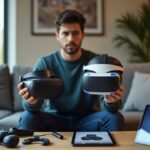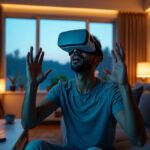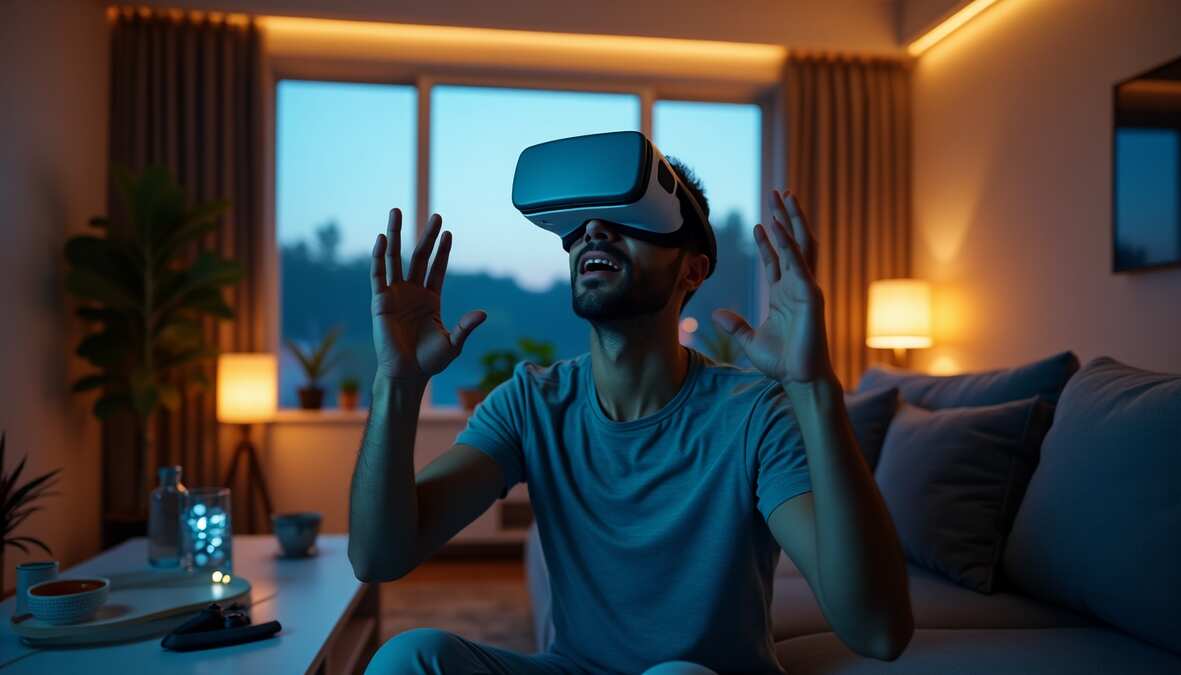Virtual Reality: The global VR headset market is booming and experts predict it will hit $313.5 billion by 2032. My first deep dive into VR options left me completely overwhelmed. There were endless specs, price points, and brands claiming their device gave the “most immersive experience.”
The best VR headset isn’t about jumping on trends or buying what everyone else has – like the Oculus Quest 2 that dominated 2021. The price range tells quite a story. You’ll find the Meta Quest Pro at $999 on one end and Apple’s Vision Pro at $3,500 on the other. VR now reaches far beyond gaming into medicine, education, and architecture. This makes your intended use a vital part of picking the right device.
The sort of thing I love to share is how to avoid the buyer’s remorse many first-timers face. Let me help you cut through the marketing hype and find a VR headset that fits your needs and budget. We’ll look at everything from the Meta Quest 3’s color passthrough camera to the HTC Vive Pro 2’s impressive 2,448 by 2,448 pixels per eye.
Why Buying Your First VR Headset Feels Overwhelming
Buying your first virtual reality headset leads to mixed feelings. You feel excited about stepping into immersive digital worlds. Yet you face an avalanche of technical specs, compatibility needs, and conflicting opinions. This overwhelming feeling isn’t just you – many first-time VR shoppers share the same experience.
The excitement vs reality of virtual reality (VR)
Virtual reality captivates almost everyone. The idea of being “fully immersed in a fabricated environment” that responds to your movements sounds amazing. Marketing teams promise life-changing experiences that will “change your life forever”. Such promises paint VR as a game-changing technology that will reshape our interaction with digital content.
All the same, real life often tells a different story. Research shows a big gap between what users expect and their first VR experience. “57% of US internet users and 48% of EU internet users believe that VR will enable them to feel as if they were in another place.” These users “seem to be over-estimating their feelings of presence in virtual reality environments”.
This gap between what people expect and what they get creates what experts call the “VR honeymoon” – that original period of wonder before reality kicks in. Many experienced VR users buy their gear “from people who had the so-called ‘short VR honeymoon'”. These sellers quickly lose interest when VR doesn’t match their high hopes.
The physical side can be tough too. New users often face:
- “Motion sickness, headaches, or eye strain, especially during longer sessions”
- The infamous “Oculus face” or “Rift rash” – red marks from “the pressure of the headset’s straps and spongy rim on the face”
- Discomfort from “strapping two pounds of stuff on their face”
Your first time might feel like “looking through a pair of rough-edged binoculars” instead of stepping into a future world, especially with basic headsets.
Common fears and doubts first-time buyers face
Physical discomfort aside, buyers face many mental hurdles that make choosing tough. These worries keep many potential buyers stuck in research mode for months.
Money versus value tops the list of concerns. Prices range from cheap smartphone viewers to systems costing thousands. Many ask themselves: “Do you find yourself playing games you don’t really want to just to use an expensive VR system?”. Fast-moving technology makes this worse, as today’s best headset might look “adorably primitive by year’s end”.
Technical specs create another big worry. VR systems need “massive CPU and GPU system requirements, somewhat beyond what you’d need for the latest videogames running at 4k resolutions”. Buyers often learn they need major upgrades beyond just the headset.
Social aspects worry potential buyers too. Despite Meta’s big push for social VR experiences, “it has become evident that most users are not particularly interested in these types of social experiences within the VR medium”. This mismatch between marketing and user behavior creates doubt about VR’s place in daily life.
Safety worries rank high among buyer concerns. Stories about motion sickness and injuries make people hesitate. One researcher points out, “The challenge is that people’s sensitivity to motion and simulator sickness varies wildly”. This makes it hard to know how you’ll react.
Platform longevity rounds out the top concerns. Nobody wants to buy tech that might become useless. One potential buyer puts it well: “I mean pretty sure meta will be around for years to come, but I have seen it at work where company drops something and you are just stuck with unusable tech”.
These factors combine to make choosing your first virtual reality headset feel daunting rather than exciting. Understanding these challenges helps you make choices based on your needs rather than marketing promises.
Top Mistakes People Make When Buying Their First VR Headset
Buying a virtual reality headset can lead to buyer’s remorse if you’re not careful. I’ve researched many VR options and made these mistakes myself. Here are the three biggest traps new buyers fall into—and how to avoid them.
Falling for marketing hype
Mark Zuckerberg once said VR adoption would “grow slowly.” Yet industry forecasts painted a different picture, suggesting explosive growth from 100,000 units to 5 million units quickly. This shows a big problem—the VR industry sets expectations too high.
The hype follows a pattern we’ve seen before. It starts with an “Innovation Trigger” as excitement builds around new technology. This builds up to the “Peak of Inflated Expectations,” driven by marketing teams promising amazing experiences. Many first-time buyers get their headsets hoping for life-changing experiences but end up disappointed.
“Some investments are being driven by grandiose expectations,” says one industry analyst. They point out that VR needs “realistic projections with realistic expectations” instead of big promises that push the industry backward.
The fix? Be skeptical about what manufacturers claim, especially when they say they’ll “transform” your life or give you “unmatched immersion.” VR technology is impressive but hasn’t reached the matrix-like experience that marketing often suggests.
Ignoring comfort and fit
Palmer Luckey, Oculus’s founder, says neck torque—not just weight—matters most for headset comfort. This explains why comfort issues make many people abandon their expensive VR gear after just a few weeks.
New buyers often miss these comfort issues:
- Pressure distribution: Headsets press against your face and leave “heavy red markings” after use—not great if you have meetings later
- Weight balance: Poor balance makes even light headsets strain your neck
- IPD adjustment: Your interpupillary distance (space between pupils) needs proper alignment to avoid eye strain
Experts suggest looking for headsets that put weight on “the harder parts of the human skull, namely the forehead and top of the head” rather than soft facial tissue. Good straps and padding make a big difference in comfort.
Heat management also plays a key role. Displays, cameras, and sensors get hot. Long sessions become uncomfortable without good ventilation, so active cooling features deserve attention.
Choosing based on price alone
The cheapest VR headset might look tempting, but it’s often a mistake. “More affordable headsets often sacrifice comfort to keep prices low,” one analysis shows. They add that “ultra-cheap options like Google Cardboard might be easy on the wallet, but they’ll be hard on the face.”
Those attractive prices often hide extra costs:
You’ll likely need accessories—many users replace the basic head strap right away: “I was so happy to pay the forty dollars [for an aftermarket head strap] but it’s the best investment that I’ve made for my quest.”
Meta Quest 2’s price looks good until you factor in subscriptions. Facebook cuts hardware costs “with their billion dollar business in order to gain massive market share” but plans to “make up their lost investment” through service fees.
Built-in speakers usually disappoint users, who buy separate headphones or earbuds to improve their experience.
Look at the total cost for a good experience instead of just the initial price. Spending more upfront often saves money and frustration later.
Read more: VR Experience
![Why Your Computer Network Security Is More Vulnerable Than You Think [2025 Guide] network security](https://vgyr.xyz/wp-content/uploads/2025/04/network-security-1-150x150.jpg)







